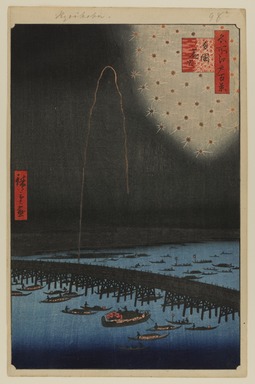
Artist:Utagawa Hiroshige
Medium: Woodblock print
Geograhical Locations:
Dates:8th month of 1858
Dimensions: Sheet: 14 1/4 x 9 1/4 in. (36.2 x 23.5 cm) Image: 13 3/8 x 8 7/8 in. (34 x 22.5 cm)
Collections:
Exhibitions:
Accession Number: 30.1478.98
Image: 30.1478.98_PS20.jpg,
Catalogue Description: This festive image shows pleasure boats on the Sumida River, with Ryogoku Bridge in the center. Elegant restaurants (north of the bridge) traditionally co-sponsored the major fireworks displays at the site, together with the boathouses. The large boat in the center is the "palace-boat," the only one of its kind to appear in this series. These grand pleasure craft were up to fifty feet in length and held as many as twenty "tatami" mats; they were hired out for parties by rich merchants. Next in size and most numerous here are the "roof boats;" the smallest are the uncovered "chokibune." Finally, there are the four boats which wandered among the pleasure boats to sell food and drink. Until 1659, all fireworks used in Japan were imported from China, but then an enterprising youth (Yabei) came to Edo and began to make his own. In 1733 he was commissioned by the shogun Yoshimune to mount a special fireworks display at the Ryogoku Bridge as a purification rite to dispel the evil spirits of the plague and famine then sweeping Japan (the first Kawabiriki- "opening river" ceremony). Only since the Meiji period have summer fireworks been reduced to a single spectacular display at the time of Kawabiriki. This particular print is very dark compared to other impressions of the image, particularly those found in the Hirose collection ("Ukiyo-e taikei').